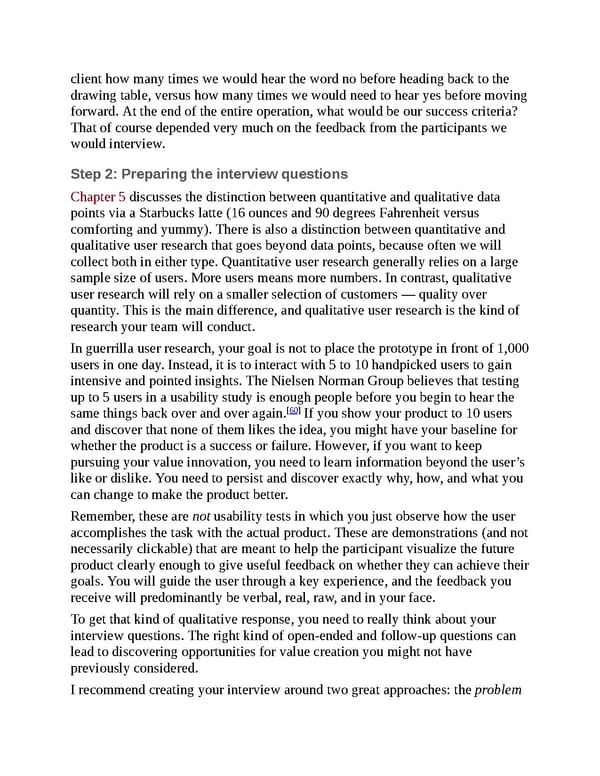client how many times we would hear the word no before heading back to the drawing table, versus how many times we would need to hear yes before moving forward. At the end of the entire operation, what would be our success criteria? That of course depended very much on the feedback from the participants we would interview. Step 2: Preparing the interview questions Chapter 5 discusses the distinction between quantitative and qualitative data points via a Starbucks latte (16 ounces and 90 degrees Fahrenheit versus comforting and yummy). There is also a distinction between quantitative and qualitative user research that goes beyond data points, because often we will collect both in either type. Quantitative user research generally relies on a large sample size of users. More users means more numbers. In contrast, qualitative user research will rely on a smaller selection of customers — quality over quantity. This is the main difference, and qualitative user research is the kind of research your team will conduct. In guerrilla user research, your goal is not to place the prototype in front of 1,000 users in one day. Instead, it is to interact with 5 to 10 handpicked users to gain intensive and pointed insights. The Nielsen Norman Group believes that testing up to 5 users in a usability study is enough people before you begin to hear the [60] same things back over and over again. If you show your product to 10 users and discover that none of them likes the idea, you might have your baseline for whether the product is a success or failure. However, if you want to keep pursuing your value innovation, you need to learn information beyond the user’s like or dislike. You need to persist and discover exactly why, how, and what you can change to make the product better. Remember, these are not usability tests in which you just observe how the user accomplishes the task with the actual product. These are demonstrations (and not necessarily clickable) that are meant to help the participant visualize the future product clearly enough to give useful feedback on whether they can achieve their goals. You will guide the user through a key experience, and the feedback you receive will predominantly be verbal, real, raw, and in your face. To get that kind of qualitative response, you need to really think about your interview questions. The right kind of open-ended and follow-up questions can lead to discovering opportunities for value creation you might not have previously considered. I recommend creating your interview around two great approaches: the problem
 UX Strategy: How to Devise Innovative Digital Products that People Want Page 223 Page 225
UX Strategy: How to Devise Innovative Digital Products that People Want Page 223 Page 225